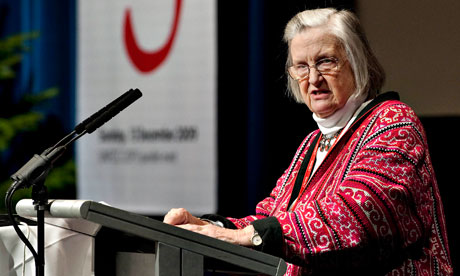
Elinor Ostrom, Nobel Prize winning economist: 7 August 1933 - 12 June 2012
Noted for her work on resource management, she was the first and (to date) only woman to win the Nobel prize for economics. She received the award, shared with Oliver E Williamson, in 2009 for her analyses of how individuals and communities can often manage common resources – ranging from irrigation and fisheries to information systems – as well or better than markets, companies or the state. Earlier this year, she appeared on Time magazine's list of the 100 most influential people in the world.From the obituary in the Guardian
Having started her career by focusing on groundwater resources in the Los Angeles basin, then studying neighbourhood policing in Indianapolis, Lin turned her attention to the subject that gained her worldwide recognition: how the overexploitation of unowned or commonly owned resources could be averted by collective action by local users.The New York Times obit has some interesting discussion about the way economics has internalized her work, which directly undermines a major assumption of neo-classical economics.
Her hugely influential 1990 book, Governing the Commons, examined numerous local management regimes for common resources and established a set of principles for predicting success and failure. It was this work, challenging the conventional wisdom of resource management, which the Nobel committee cited as her primary contribution to economics. But it was far from her only major contribution.
The Ostrom name will for ever be associated with two related frameworks for social-scientific analysis: the institutional analysis and design (IAD) framework and the still-evolving social-ecological systems (SES) framework. The former received its most comprehensive treatment in her 2005 book, Understanding Institutional Diversity, and has become one of the leading analytical tools in the study of public policy. While IAD focused on social rules governing resource use, the SES framework, which pays equal attention to ecological features, will be among Lin's legacies to social science. She also provided a model for breaking down disciplinary boundaries so that researchers from diverse fields could collaborate. In her 2010 book, Working Together: Collective Action, the Commons, and Multiple Methods in Practice, Lin and her co-authors offered concrete ideas to make collaboration more successful.
Professor Ostrom’s prizewinning work examined how people collaborate and organize themselves to manage common resources like forests or fisheries, even when governments are not involved. The research overturned the conventional wisdom about the need for government regulation of public resources. At least it did for the economists who knew who she was and had read her work.Resilience Science has personal reflections from a number of her colleagues.
“The announcement of her prize caused amazement to several economists, including some prominent colleagues, who had never even heard of her,” Avinash Dixit, a Princeton economics professor, said when introducing Professor Ostrom’s work at a luncheon in 2011. Usually, he noted, Nobel laureates need no introduction. In fact, when the Nobel recipients were announced, some economists mistakenly thought the prize had gone to Bengt Holmstrom, an economist with a similar-sounding (and, to economists, much more recognizable) name. One prominent scholar acknowledged visiting Wikipedia to figure out who exactly she was.
Surprise at Professor Ostrom’s honor, which she shared with Oliver E. Williamson, in some cases gave way to disdain and name-calling on economics blogs. “Some things said about her in blogs and other media were so ignorant and in such bad taste that I felt ashamed on behalf of the economics profession,” Mr. Dixit said.

No comments:
Post a Comment